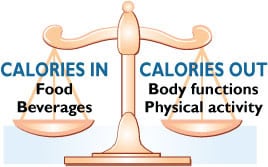Balancing Calories
Posted on: December 11, 2012Categories: LiveWell 24/7There is a lot of talk about low carbohydrate diets, low fat diets, high protein diets, and every combination of the three. What these three macro-nutrients have in common is that they all contain calories. Calories are where your focus should be when managing your weight. To maintain a healthy weight for life, you need to have a caloric balance. A caloric balance means balancing the number of calories consumed with the number of calories used.

Think of the caloric balance like a scale. To maintain a healthy weight, your calories consumed from food and beverages must be balanced by the calories your body is using though bodily functions, daily activities, and exercise. If you are consuming more calories than your body is using, you are in caloric excess. These extra calories will be stored as fat and you will gain weight. If you are eating less calories than your body is using, your body will pull from its fat storage cells for energy. This will cause your weight to decrease.
Am I in Caloric Balance?
The ultimate test of balance is whether or not you are gaining, maintaining, or losing weight. If you are maintaining your body weight, you are in caloric balance. To gain or lose weight, you will need to tip the scale to one side or the other.
It takes approximately 3,500 calories below your calorie needs to lose 1 pound of body fat. To lose 1-2 pounds per week, you will have to lower your caloric intake by 500-1000 calories per day.
To learn how many calories you are currently consuming, keep a written record of what you are eating and drinking daily. This will help you become more aware of every little thing you are putting in your mouth. Tracking your physical activity is also a great idea to help you stay accountable. The Center for Disease Control website offers great printable food and physical activity diaries here: http://www.cdc.gov/healthyweight/calories/index.html
In our technological age, there are many smart phone applications where you can track your food and activity easily. Some examples of these are: Lose It!, Calorie Tracker, Health Cubby, Mint Nutrition, The Carrot, FoodPlannerLite, and MyFitnessPal.
Each person’s body is unique and may have different caloric needs. A healthy lifestyle requires balance in the foods you eat, in the beverages you consume, in the way you carry out your daily activities, and in the amount of physical activity or exercise you include in your daily routine.
Physical Activity
Physical activity (both daily activities and exercise) can help you tip the scale by increasing the number of calories expended each day. It is recommended that you participate in 2 hours and 30 minutes of moderate aerobic activity each week. This can be as simple as a brisk 30 minute walk each day. It is also recommended that you include muscle-strengthening activities on two or more days a week that work all major muscle groups. Increasing the intensity or amount of time that you are physically active can have even greater health benefits and may be necessary for weight control. Teenagers and children should be active for at least 60 minutes every day.





